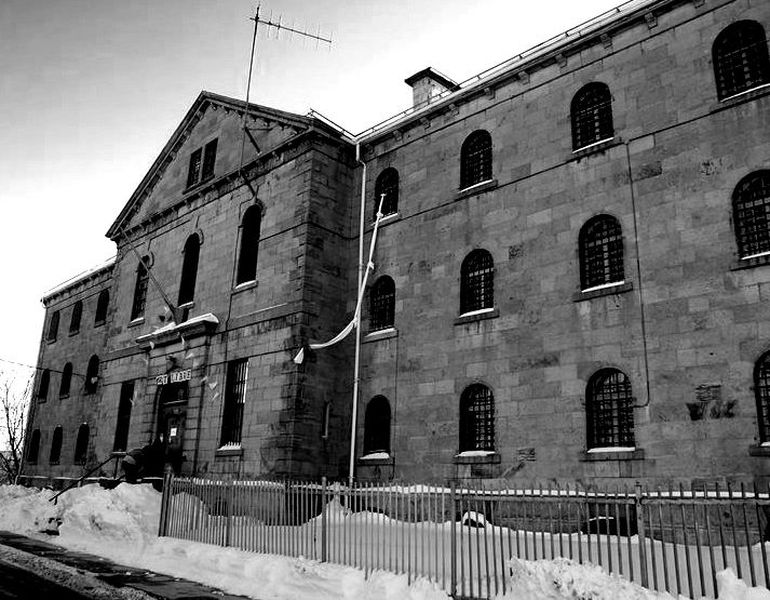
Winter Street Prison
Sherbrooke, Québec – CRUMBLING BEHIND BARS
The future of the Winter Prison complex remains uncertain. This unique historic landmark is succumbing to decay and neglect. Due to its advanced state of disrepair, the Régie du bâtiment condemned the building in April 2007.
The Winter Prison was saved from the wrecking ball by a local group committed to its rehabilitation and continued community use. Local groups often end up burdened with high maintenance and restoration costs of municipally and provincially significant heritage places.
Financial incentives from all levels of government are needed to ensure the landmark’s future viability.
 Background
Background
Built in 1865 by Charles Côté following the plans of architect Frederic Preston Rubidge, the stone building is a Palladian-type structure that retains much of its architectural integrity and authenticity.
The prison complex consists of a main building, a unique stone fence penitentiary wall, an interior court, green spaces, the jailor’s house, and a brick building dating from 1940.
The prison is the oldest stone structure in Sherbrooke and the city’s third oldest public building. It continued its original function until 1990, when the prison was moved to more modern facilities.
The Société de sauvegarde de la vieille prison de Sherbrooke was created in 1989 in reaction to the threat of its demolition at the time of the prison’s closure. The society is mandated to work with the city and the public to find solutions to ensure the site’s long-term survival and adaptive reuse. In 1997, to ensure its protection, the group bought the prison for 1$ from the provincial Ministry of culture. [Ministère de la culture et des communications].
Even though the local group has been working for almost 20 years to prevent deterioration, neglect and vandalism, it is overwhelmed by the current state of the prison’s significant heritage elements such as the penitentiary wall, the exterior masonry wall and the roof. The society wishes to raise awareness of the urgency of the building’s condition and engage all levels of government as well as the public in helping to bring it up to code.
Although the group has submitted several applications for heritage designation to the Ministry of Culture, little has been done. “The Winter Prison does not seem to be a priority for the provincial government,” notes Daniel Quirion from the society. “It’s now time to act, or else it will be too late for the prison.”
Although the Ministry has invested in numerous studies, the prison is not protected under Quebec’s Cultural Property Act. [Loi sur les biens culturels]
Sensitive to the heritage character of the site and the public’s appreciation of the complex, the City of Sherbrooke has moved ahead by integrating it into the municipality’s official plans: Plan d’implantation et d’intégration architecturale de la Ville de Sherbrooke.
The local population has become quite familiar with the location as it housed activities of an arts group, Art Libre until its recent closure.
Located next to the Magog River in the heart of the old Sherbrooke heritage district, the prison could become the catalyst for the revitalization of the surrounding area for the benefit of tourists and the community.
The Conseil des monuments et des sites du Québec has already urged local stakeholders, such as elected officials, the public and the corporation Sherbrooke, Cité des rivières to integrate the prison in future revitalization plans. There is a strong will among community members and the municipality to revitalize the area in order to make it “tourist-ready.”
Top 10 Endangered Places
- Explore Past Listings
- National
- British Columbia
- Alberta
- Saskatchewan
- Manitoba
- Ontario
- Quebec
- Bens
- Cap-des-Rosier Lighthouse National Historic Site
- Cathédrale Saint-Germain
- Estate of the Pères de Sainte-Croix
- Franciscan
- Grenville Canal
- Louis Hippolyte
- Québec - Redpath Mansion
- Saint-Vincent-de-Paul Penitentiary
- Southwest
- Très-Saint-Nom-de-Jésus
- Ville Marie
- Wallingford-Back Mine
- Winter Street Prison
- Wright Scott
- Sillery District
- Hôpital de la Miséricorde
- The Quebec Bridge
- New Brunswick
- Nova Scotia
- Prince Edward Island
- Newfoundland and Labrador
- Territories
- Worst Losses Archive
- Nominate a Site
